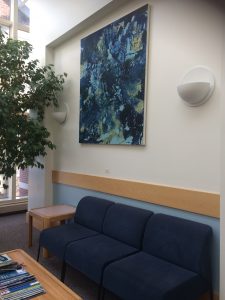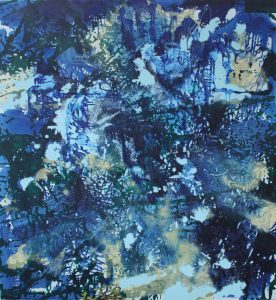Our Tuesday’s Objet series (pronounced “OB-JAY” from the French word for “object”) intends to highlight pieces on display outside the physical confines of our gallery spaces, to draw attention to the art that surrounds us on a daily basis.
Today we’re headed to the 3rd floor of the biology building. In the student lounge, to the right both entrance doors, lives Web, an oil painting by Rosalyn Richards.

Richards received her BFA from the Rhode Island School of Design, and her MFA from Yale University School of Art. She taught drawing and printmaking at Bucknell from 1982 to 2014. We have a multitude of her work in our permanent collection, and Web specifically was included in a recent exhibition curated by our Gallery Engagement Team.
Richards explores the inner world of natural elements and processes through painting, printmaking, and drawing. She’s inspired by images culled from scientific disciplines such as biology, particle physics, satellite photography, biotechnology, radiology, and geological survey maps. Her work engages with our understanding of the natural world, a perspective that is largely mediated by technology. She describes her images as “metaphors for the human impulse to search for hidden meaning within… natural structures.”[1] At first glance, Richards’ work reads like an abstracted canvas in rich greens and blues. Looking closer, the saturated color palette juxtaposes organic forms in a collage-like manner. They are definitely reminiscent of organic structures like coral or webbing.

Richards’ creative impulses reminded me of a class I took in graduate school, which paralleled the rise of empiricism in the early modern period with its visual depictions in prints. The class’s theoretical framework focused on the epistemological shift of the practice of observation. Prior to the early modern period, observation was considered an anecdotal process, something associated more with divination than science. But, with the invention of the telescope and the microscope, we were no longer limited to what our naked eyes could sense. Whole worlds opened up, from the cosmic to the microscopic. Eventually observation was intertwined with experiment, as a fundamental component to scientific inquiry. With the aid of sense-enhancing instruments, this symbiotic pairing yielded a plethora of scientific discoveries, from Galileo’s recording of the moon’s surface to the beginnings of cell biology. I link Richards’ interest in making the invisible visible to the inevitable reverberations of this larger culture advancement.
If you’d like to know more about Rosalyn and her work, check out her website. If the intricate history of observation intrigues you, check out this book, which was the epistemological backdrop of the course I took.
[1] “Artist Statement,” Rosalyn Richards, accessed November 11, 2016, http://www.rosalynrichards.com/artist-statement/.

